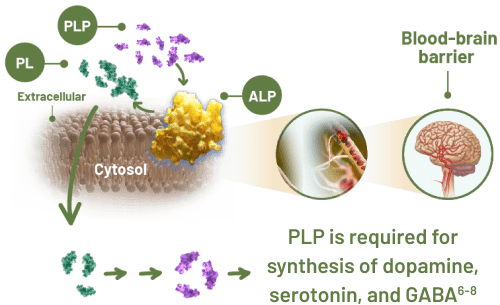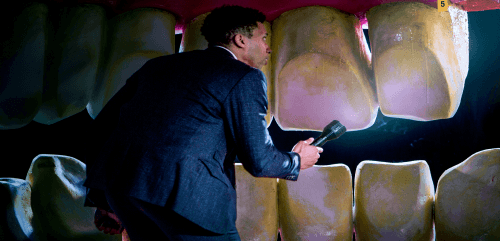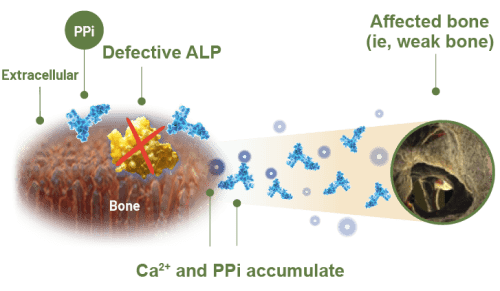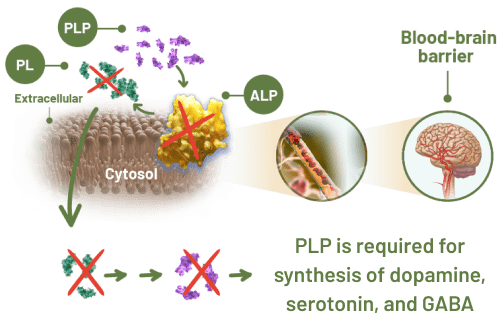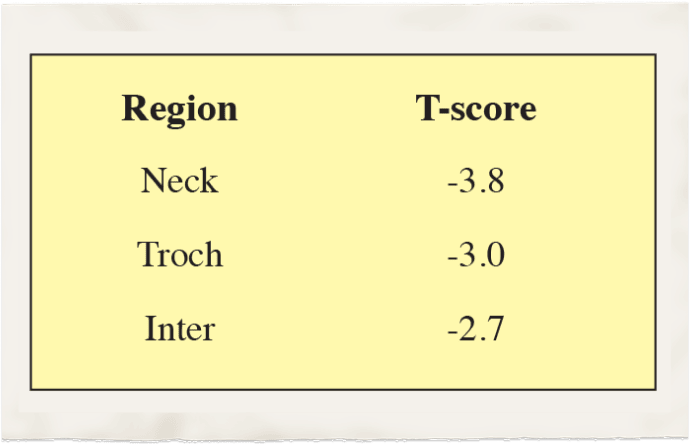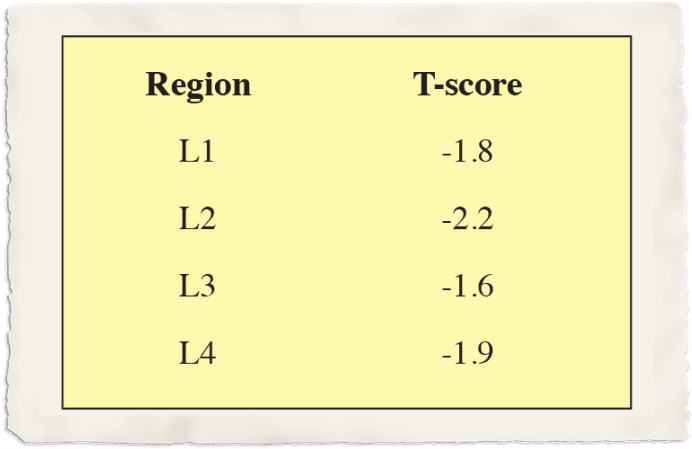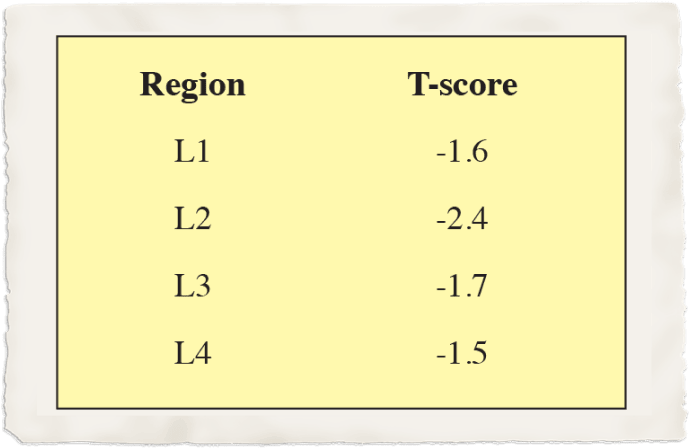References: 1. Rockman-Greenberg C. Hypophosphatasia. Pediatr Endocrinol Rev. 2013;10(suppl 2):380-388. 2. Medline Plus. ALPL gene. National Library of Medicine. 2018. Accessed March 30, 2023. https://medlineplus.gov/genetics/gene/alpl/ 3. Weber TJ, Sawyer EK, Moseley S, et al. Burden of disease in adult patients with hypophosphatasia: results from two patient-reported surveys. Metabolism. 2016;65(10):1522-1530. 4. Hӧgler W, Langman C, Gomes da Silva H, et al. Diagnostic delay is common among patients with hypophosphatasia: initial findings from a longitudinal, prospective, global registry. BMC Musculoskelet Disord. 2019;20(1):80. 5. Bianchi ML, Bishop NJ, Guañabens N, et al; Rare Bone Disease Action Group of the European Calcified Tissue Society. Hypophosphatasia in adolescents and adults: overview of diagnosis and treatment. Osteoporos Int. 2020;31(8):1445-1460. 6. Mercimek-Mahmutoglu S, Sidky S, Hyland K, et al. Prevalence of inherited neurotransmitter disorders in patients with movement disorders and epilepsy: a retrospective cohort study. Orphanet J Rare Dis. 2015;10:12. 7. Cellini B, Montioli R, Oppici E, Astegno A, Borri Voltattorni C. The chaperone role of the pyridoxal 5’-phosphate and its implications for rare diseases involving B6-dependent enzymes. Clin Biochem. 2014;47(3):158-165. 8. Pierpont EI, Simmons JH, Spurlock KJ, Shanley R, Sarafoglou KM. Impact of pediatric hypophosphatasia on behavioral health and quality of life. Orphanet J Rare Dis. 2021;16(1):80. 9. McKiernan FE, Dong J, Berg RL, et al. Mutational and biochemical findings in adults with persistent hypophosphatasemia. Osteoporos Int. 2017;28:2343-2348. 10. Shajani-Yi Z, Ayala-Lopez N, Black M, Dahir KM. Urine phosphoethanolamine is a specific biomarker for hypophosphatasia in adults. Bone. 2022;163:116504. 11. Nunes ME. Hypophosphatasia. In: Adam MP, Ardinger HH, Pagon RA, et al, eds. GeneReviews®. University of Washington; 2007. Accessed March 30, 2023. https://www.ncbi.nlm.nih.gov/books/NBK1150/ 12. Conti F, Ciullini L, Pugliese G. Hypophosphatasia: clinical manifestation and burden of disease in adult patients. Clin Cases Miner Bone Metab. 2017;14(2):230-234. 13. Salles JP. Hypophosphatasia: biological and clinical aspects, avenues for therapy. Clin Biochem Rev. 2020;41(1):13-27. 14. Colazo JM, Hu JR, Dahir KM, Simmons JH. Neurological symptoms in hypophosphatasia. Osteoporos Int. 2019;30(2):469-480. 15. Mornet E. Molecular genetics of hypophosphatasia and phenotype-genotype correlations. Subcell Biochem. 2015;76:25-43. 16. NORD. Hypophosphatasia. 2022. Accessed March 30, 2023. https://rarediseases.org/rare-diseases/hypophosphatasia/ 17. Rush ET, Moseley S, Petryk A. Burden of disease in pediatric patients with hypophosphatasia: results from the HPP Impact Patient Survey and the HPP Outcomes Study Telephone interview. Orphanet J Rare Dis. 2019;14(1):201. 18. Vieira LHR, Peixoto KC, Flósi CL, Fleiuss de Farias ML, Madeira M. Active search of adult patients with persistently low serum alkaline phosphatase levels for diagnosis of hypophosphatasia. Arch Endocrinol Metab. 2021;65(3):289-294. 19. McKiernan FE, Berg RL, Fuehrer J. Clinical and radiographic findings in adults with persistent hypophosphatasemia. J Bone Miner Res. 2014;29(7):1651-1660. 20. Adeli K, Higgins V, Nieuwesteeg M, et al. Biochemical marker reference values across pediatric, adult, and geriatric ages: establishment of robust pediatric and adult reference intervals on the basis of the Canadian Health Measures Survey. Clin Chem. 2015;61(8):1049-1062. 21. Schumann G, Klauke R, Canalias F, et al. IFCC primary reference procedures for the measurement of catalytic activity concentrations of enzymes at 37 °C. Part 9: reference procedure for the measurement of catalytic concentration of alkaline phosphatase International Federation of Clinical Chemistry and Laboratory Medicine (IFCC) Scientific Division, Committee on Reference Systems of Enzymes (C-RSE) (1)). Clin Chem Lab Med. 2011;49(9):1439-1446. 22. Quest Diagnostics. Alkaline phosphatase. Accessed March 30, 2023. https:/testdirectory.questdiagnostics.com/test/test-detail/234/alkaline-phosphatase? cc=MASTER 23. Labcorp. Alkaline phosphatase. Accessed March 20, 2023. https://www.labcorp.com/tests/001107/alkaline-phosphatase# 24. ARUP Laboratories. Alkaline phosphatase isoenzymes, serum or plasma. Accessed March 30, 2023. https://ltd.aruplab.com/Tests/Pub/0021020 25. Colantonio DA, Kyriakopoulou L, Chan MK, et al. Closing the gaps in pediatric laboratory reference intervals: a CALIPER database of 40 biochemical markers in a healthy and multiethnic population of children. Clin Chem. 2012;58(5):854-868. 26. Bishop N, Munns CF, Ozono K. Transformative therapy in hypophosphatasia. Arch Dis Child. 2016;101(6):514-515. 27. Whyte MP. Hypophosphatasia: nature's window on alkaline phosphatase function in humans. In: Bilezikian JP, Raisz LG, Martin TJ, eds. Principles of Bone Biology. 3rd ed. Academic Press; 2008:1573-1598.

